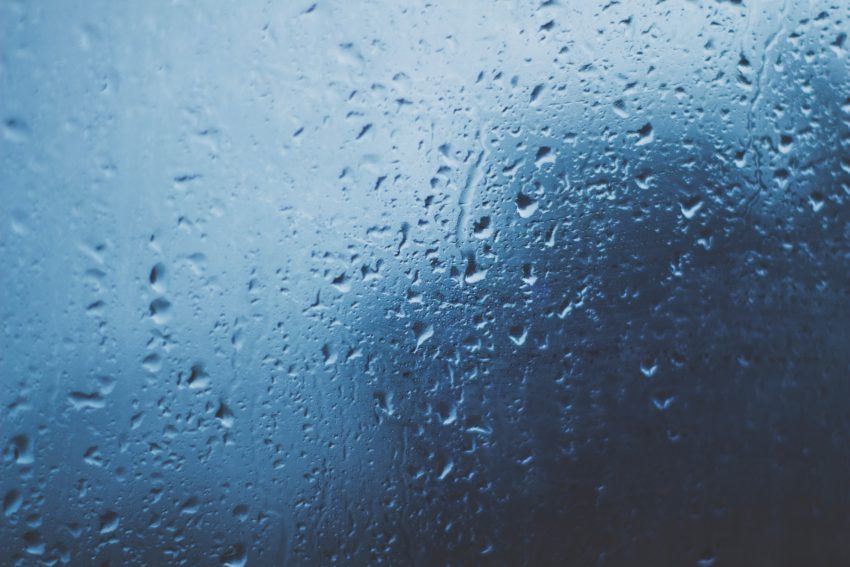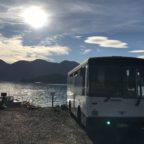It’s cooling down and there’s condensation developing on your windows and metal linings in the morning. Droplets form then run down and wet timber or items in storage. Condensation’s no good for books either and left unchecked can encourage moulds, mildew, rot, or rust.
But how can you deal with condensation in winter?
Dehumidifier? Log burner? Insulation?
What works? What are the pros and cons of each solution?
This article is full of great ideas for how to reduce condensation in your camper this winter.
What causes condensation?
Condensation develops when warm, moist air touches cold surfaces causing it to release its moisture in small droplet form on that surface.
Condensation usually happens on the inside of surfaces like windows since it’s often warmer on the inside compared to outside temperatures.
If the outside and inside temperatures matched, you could avoid condensation but that would be uncomfortably cold in winter!
Unless you’re moving to warmer climes then the solution to condensation is to reduce or remove the moisture from the air inside your vehicle.
How do I reduce condensation in my camper?
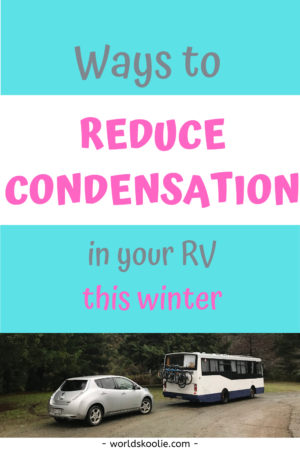
Many daily activities in campers put moisture into the air inside like cooking or drying clothes.
So when it comes to figuring out how to reduce your moisture, you may need to experiment to find out what works best for you in your circumstances.
Here are our top tips for reducing moisture in your camper in winter along with their pros and cons.
Ventilate
Opening vents and windows lets moisture escape and allows drier outdoor air in. This will help reduce condensation forming and help clear any that has shown up inside overnight. Open windows on opposite sides every day for 10 minutes, even in winter.
Pros:
- Moves the moist air out of your vehicle and reduces condensation on windows.
- Helps keep mould at bay.
Cons:
- It can be cold having vents or doors open in the winter.
- Some locations are so windy it’s not practical to leave doors or vents open.
Use a log burner
Pros:
- These are commonly hailed as the best anti-condensation device since they provide dry heat.
- Saves you on power costs.
- Warm and cosy to be around.
Cons:
- Cost and space required to install.
- Ongoing cost of buying wood.
- Limited storage space means stockpiling your wood when it’s cheap or free is often impossible.
- Sometimes getting wood in remote locations or during winter is a hard or unpleasant task.
Install a diesel heater
When we built out our bus motor home, compact diesel heaters were coming to the market.
We bought our 5KW heater from AliExpress and installed it ourselves. It used a tiny amount of space and we’ve never been sorry about our decision, especially living in it through the winter months.
We know several others who now have diesel heaters in their campers or boats and they rave about them too.
Pros:
- Cheap 12V alternative to log burners.
- Small (approx 40 x 15 x 15cm) and efficient units so take up little space.
- Comes with a digital display unit and remote to adjust settings with.
- A 5 or 8KW model generates enough heat for your entire internal camper space.
- Can be ordered online to save you hundreds.
- Comes with instructions so you can install it yourself.
- Burns diesel – up to a cup an hour depending on heat settings – making it cheap to run over time.
Cons:
- Wait time for delivery from overseas.
- Cost to get it installed if not doing this yourself.
Alter your cooking habits
Stove cooking releases steam into the air. This is moisture-filled air.
To reduce the amount of moisture being released, cover pots and pans with lids. This speeds up cooking too so that’s a win-win.
Of course, if you can, avoid using your stovetop as much in winter.
Instead, you could try these options:
Use your oven – gas ones still add some moisture so ideally a convection is best if you have the option.
Use a crock or instant pot – these electrical appliances are super handy as they trap the moisture inside as they cook. You can even release their steam outside once they’re done cooking.
This Living & Co. Warehouse NZ pressure cooker has good reviews. Amazon supplies a range of Instant Pots but check they’ll work in your van before buying as appliance plugs and voltage can differ.
Cook outdoors – this takes away all issues of releasing steam into the air inside, especially during evenings. Outdoor cooking can be fun but poor weather can be a deterrent.
Many people swear by a portable Weber BBQ because they’re small, portable and cook efficiently with LPG which is easy to get almost anywhere.
We use a Baby Q1200 and love it’s compact size, cooking speed, and that you can catch all the fat and juices in a disposable tray underneath making clean up easy.
For extra cost you can also buy stands and other accessories like covers for them.
Powered/ Vent Fans
Many campers have an extractor above their stoves and one or two in their ceilings.
You can use these to move air in and out of your vehicle.
If you’re blessed, one fan can draw air in up the front and one can expel it in the back. This can have an HRV effect and works for you in both summer and winter.
Pros:
- Expels moist air.
- MaxxAir units come recommended. They have multiple speeds in forward and reverse directions so you can set it to run at the capacity you need at a given time.
- The Maxxfan Deluxe is a complete RV ventilation system that incorporates a vent, a fan, a remote control and rain protection all in a single unit. The 7000K is easy to operate, easy to clean, and with a 12-volt fan motor that moves over 900 cubic feet of air per minute.
- It quickly and efficiently pulls fresh air in while removing hot, stale air and odours.
- Adjustable fan speeds, a built-in thermostat, a built-in rain cover, and a white lid that closes securely for a streamlined appearance, this would be a great addition to any RV.
Cons:
- Purchase price ($580 each) and installation cost.
- Running a fan uses power so you have to up your battery/ solar setup or plug in.
- You need to make a point of opening your vents daily and running the fans to push out moist air.
Squeegee your windows
Karcher Window Vacuum
Pros:
- The Karcher Window Vacuum does an admirable job cleaning and removing condensation from windows
- It does what it says on the box.
- Its advantage over a standard squeegee is you won’t end up with puddles of water seeping into your frames, though you’ll often need a cloth to mop up the last bit of water at the bottom of your windows.
Cons:
- It can leave streaks unless you use lashings of window cleaner and press the vac firmly at the right angle.
- Not great if your windows are set back into the frame, or on windows that run to the ground.
- Costs from $118 so most of us could be content with a normal squeegee and cloth.
An alternative is…
Scoopy
Pros:
- The Scoopy comes with a squeegee head, reservoir handle, and microfibre cloth.
- Travels smoothly up wet windows
- Condensation goes straight into the handle (holds 150ml) which can easily be poured out, leaving windows dry.
- The microfibre cleaning cloth leaves windows 100% dry, clean, and streak-free.
- Priced much cheaper than Karcher Window Vac at only $22.
Con:
- Still awkward at the bottom of windows if the handle can’t go low enough at the right angle to the window.
Dehumidifier
Removing moisture from the air helps reduce condensation. Dehumidifiers are one way to do this. They recycle your air, removing the moisture, and condensing it into a removable tank or tray you can empty.
Pros:
- Very good at removing air moisture making air warm and dry inside.
- Come in a variety of sizes so you could choose one to suit you and your space.
- Once they’ve removed the damp they cost little to run and work less hard.
- Can be run on a timer to reduce running noise during sleep hours if it bothers you.
Cons:
- We run a dehumidifier in our camper to dry out furnishings ahead of winter. It’s the one we used in our house and does the job well but is too large and bulky to keep on board permanently.
- Takes time to do its work.
- Power cost and space to store.
- They run hard at first and may be noisier while removing high levels of damp from soft furnishings like padded seating and bedding.
- Cost can be high/ variable – check out Priceme when comparing suppliers for a given model.
If you’re looking to buy one, Mitsubishi comes recommended by Consumer for reliability. Available new or on Trademe.
Avoid hanging things to dry inside
Don’t add to the humidity inside your vehicle by adding moisture to the air by hanging wet or damp items to dry inside.
This can release up to 3 litres of moisture into the air per washing load.
Rather use laundry dryers or outside lines and spots for drying wet clothes or shoes.
If you have to dry clothes inside, do so away from living and sleeping areas, with the door shut & window open.
Pro:
- Drying your gear outside keeps inside air drier.
Cons:
- Finding places to hang items.
- Stringing washing lines.
- Higher laundromat costs in winter due to more drying.
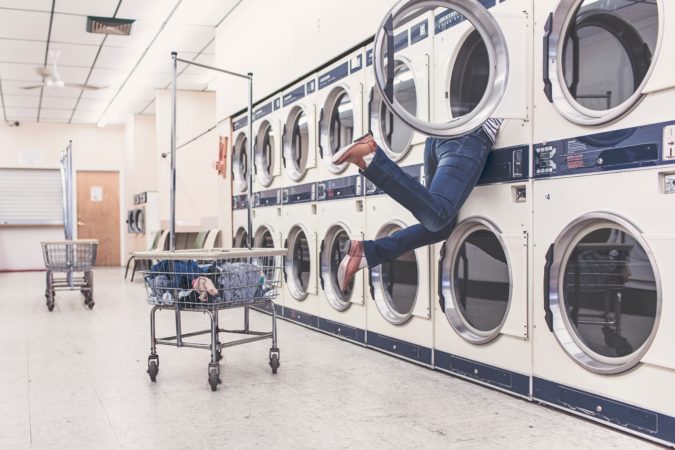
Electric Heaters
If you have access to power, you can run mobile heaters or other warming accessories like towel rails.
Pros:
- Being warm right away.
- Long term stay places can work out quite economical for power.
- Even 50W towel rails can take the edge off on cold days and nights and warm your clothes.
Cons:
- Cost of paying for electricity.
- Storage space required for the unit.
Avoid Gas Heaters
You may feel almost instantly warm with these on but they pump moisture into the air as they burn and can be dangerous because they burn oxygen in the surrounding air.
Pro:
- Provides immediate warmth and can seem cheap.
Cons:
- Add moisture to the air as they burn, worsening condensation.
- Hazardous in small spaces.
- On high they can chew through gas.
Insulation
You can line walls and under floors with polystyrene sheets to the outside followed by 35mm wool insulation then top with ply and/or carpet linings inside.
Pro:
- Creates a double-glazing effect.
Con:
- Cost to insulate if building from scratch
- If you buy an un-insulated vehicle, it can be difficult or costly to retrofit insulation.
DIY Window Insulation
DIY window insulation kits consist of a clear plastic film that is taped to the inside of the window frame and shrunk to fit. This acts like double glazing but is much more affordable than permanent glazing and useful where doubling glazing isn’t an option.
Pros:
- It reduces condensation and heat loss by acting as double glazing.
- You only need a hairdryer and a pair of scissors to install it.
- Can be easily removed from most surfaces without marks.
- Independent research has shown DIY window insulation performs as well as some other forms of retrofit double glazing.
- Several sizes are available to suit most windows.
- Helps prevent heat loss.
Kits available:
-
- Standard kit for normal-sized windows: 157cm x 533cm ($30)
-
- Standard kit for large windows/patio door: 213cm x 305cm ($45)
-
- Roll-on kit for normal sized windows: 157cm x 508cm ($45)
Package includes clear window film, double-sided tape, alcohol wipes, and instructions. DIY window insulation comes in a standard pack or with a pre-taped top edge for easy roll-on application.
You can buy the kits above from CEA NZ or another similar US version from Frost King.
Cons:
- Please note these window kits are not recommended for use on plaster, drywall/wallboard and unfinished/unvarnished wood.
- Requires installation effort and a hairdryer.
Other options:
Got any other tips for reducing condensation in your camper in the winter?
Share them with us and we’d be happy to add them into this post.
Please pin an image below.

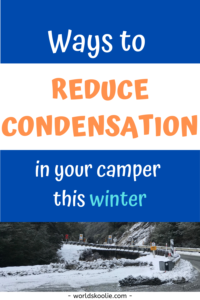

Thanks!

Meagan

